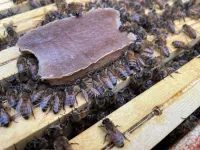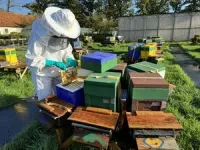(Press-News.org) PULLMAN, Wash., -- Scientists have unveiled a new food source designed to sustain honey bee colonies indefinitely without natural pollen.
Published April 16 in the journal Proceedings of the Royal Society B, the research from Washington State University and APIX Biosciences NV in Wingene, Belgium details successful trials where nutritionally stressed colonies, deployed for commercial crop pollination in Washington state, thrived on the new food source.
This innovation, which resembles the man-made diets fed to livestock and pets all their life, contains all the nutrients honey bees need. It’s expected to become a potent strategy for combating the escalating rates of colony collapse and safeguarding global food supplies reliant on bee pollination.
The newly developed food source resembles human “Power Bars”. These are placed directly into honey bee colonies, where young bees process and distribute the essential nutrients to larvae and adult bees.
This breakthrough addresses one of the growing challenges faced by honey bees: lack of adequate nutrition in their environment.
“Changes in land use, urban expansion, and extreme weather all negatively impact nutrition for honey bees and other pollinators," said Brandon Hopkins, P.F. Thurber Endowed Distinguished Professor of Pollinator Ecology at WSU and a co-author of the paper. "Honey bees are generalists and do not get all their nutrition from a single source. They need variety in their diet to survive but find it increasingly difficult to find the continuous supply of pollen they need to sustain the colony."
Dr. Patrick Pilkington, CEO of APIX Biosciences US, emphasized the significance of this development.
"Until this study, honey bees were the only livestock that could not be maintained on a man-made feed,” Pilkington said. “The reported scientific work shows in commercial field conditions that providing nutritionally stressed colonies with our pollen-replacing feed results in a major measurable step change in colony health compared to current best practices. Our product has the potential to change the way honey bees are managed.”
The research, a culmination of over a decade of work, involved extensive collaboration. Thierry Bogaert, lead author and chairman of APIX Biosciences, highlighted the collaborative effort.
"The newly published work is the result of a herculean scientific effort of three teams,” Bogaert said. “First, the founders and scientists of APIX Biosciences who tested thousands of combinations of ingredients on honey bees over more than 10 years to create this feed. Second, the WSU team with leading honey bee and field expertise, and, third, leading beekeepers in California together with extension teams. They made large scale and science-based field testing of feeds possible. Paper co-author Anne Marie Fauvel managed that third aspect.”
A critical discovery within the research is the role of isofucosterol, a molecule found naturally in pollen that acts as a vital nutrient for honey bees. Colonies fed with isofucosterol-enriched food survived an entire season without pollen access, while those without it experienced severe declines, including reduced larval production, adult paralysis, and colony collapse. The new feed also contains a comprehensive blend of the other nutrients honey bees require.
To validate the efficacy of the new food source under real-world conditions, WSU conducted field trials with nutritionally stressed colonies in blueberry and sunflower fields, both known for poor pollen quality for bees. Compared to colonies receiving standard commercial feed or no supplementation, those fed the new food source thrived, demonstrating increased survival and colony growth.
"Some beekeepers don’t pollinate blueberries anymore because colonies suffer or die and the pollination fees don’t cover the losses,” Hopkins said. “Blueberry pollen isn’t very nutritious for honey bees, and they aren’t adapted well to pollinating that crop. But if they have this supplemental food source, beekeepers may return to pollinating those fields since they know their bees are more likely to survive."
The severe challenge of high annual colony mortality, with recent reports indicating crisis-level losses, underscores the urgency of this innovation.
Pilkington expressed optimism about the discovery’s impact.
"We are confident that the product will positively impact beekeepers and growers once it’s available to purchase in the US, which is targeted for mid-2026,” he said. “Meanwhile we are working with WSU and the beekeeping community across the USA to develop the best way to make use of this new tool in agricultural settings.”
END
New pollen-replacing food for honey bees brings new hope for survival
Healthier honey bees offer potential to boost crop yields
2025-04-16
ELSE PRESS RELEASES FROM THIS DATE:
Gene-based blood test for melanoma may catch early signs of cancer’s return
2025-04-15
Monitoring blood levels of DNA fragments shed by dying tumor cells may accurately predict skin cancer recurrence, a new study shows.
Led by researchers at NYU Langone Health and its Perlmutter Cancer Center, the study showed that approximately 80% of stage III melanoma patients who had detectable levels of circulating tumor DNA (ctDNA) before they started treatment to suppress their tumors went on to experience recurrence.
The researchers also found that the disease returned more than four times faster in this group than in those with no detectable levels of the biomarker, and the higher ...
Common genetic variants linked to drug-resistant epilepsy
2025-04-15
Certain common genetic changes might make some people with focal epilepsy less responsive to seizure medications, finds a new global study led by researchers at UCL and UTHealth Houston.
Focal epilepsy is a condition where seizures start in one part of the brain. It is the most common type of epilepsy.
Antiseizure medication is usually prescribed for people with the condition. However, for one in three people with epilepsy (around 20 million individuals worldwide), current antiseizure medications are ineffective. This means ...
Brisk walking pace + time spent at this speed may lower risk of heart rhythm abnormalities
2025-04-15
A brisk walking pace, and the amount of time spent at this speed, may lower the risk of heart rhythm abnormalities, such as atrial fibrillation, tachycardia (rapid heartbeat), and bradycardia (very slow heartbeat), finds research published online in the journal Heart.
The findings were independent of known cardiovascular risk factors, but strongest in women, the under 60s, those who weren’t obese, and those with pre-existing long term conditions.
Heart rhythm abnormalities (arrhythmias) are common, note the authors, with atrial fibrillation ...
Single mid-afternoon preventer inhaler dose may be best timing for asthma control
2025-04-15
A single daily preventer dose of inhaled corticosteroid (beclomethasone), taken mid afternoon, may be the best timing for effective asthma control as it suppresses the usual nocturnal worsening of symptoms more effectively than dosing regimens at other times of the day, suggest the results of a small clinical trial published in the journal Thorax.
If the findings are confirmed in larger studies, this approach may lead to better clinical outcomes for patients without increasing unwanted steroidal ...
Symptoms of ice cold feet + heaviness in legs strongly linked to varicose veins
2025-04-15
Hypersensitivity to the cold, especially ice cold feet, as well as a feeling of heaviness in the legs, are linked to the presence of varicose veins, finds a large study published in the open access journal Open Heart.
Cold hypersensitivity is often underestimated as a subjective symptom, say the researchers.
Varicose veins are usually caused by impaired functioning of the deep or superficial veins, and the perforator veins (short veins that link the superficial and deep venous systems in the legs).
The prevalence of varicose veins ranges from 2% to 30% in adults, with women at higher risk. And symptoms include sensations ...
Brain areas necessary for reasoning identified
2025-04-15
A team of researchers at UCL and UCLH have identified the key brain regions that are essential for logical thinking and problem solving.
The findings, published in Brain, help to increase our understanding of how the human brain supports our ability to comprehend, draw conclusions, and deal with new and novel problems – otherwise known as reasoning skills.
To determine which brain areas are necessary for a certain ability, researchers study patients with brain lesions (an area of damage in the brain) caused by stroke or brain tumours. This approach, known ...
Growing wildflowers on disused urban land can damage bee health
2025-04-15
Wildflowers growing on land previously used for buildings and factories can accumulate lead, arsenic and other metal contaminants from the soil, which are consumed by pollinators as they feed, a new study has found.
The metals have previously been shown to damage the health of pollinators, which ingest them in nectar as they feed, leading to reduced population sizes and death. Even low nectar metal levels can have long-term effects, by affecting bees’ learning and memory - which impacts their foraging ability.
Researchers have found that common plants including white clover and bindweed, which ...
Rapid rise in vaping in Britain has stalled
2025-04-15
The study, published in the journal Addiction and funded by Cancer Research UK, looked at survey data on vaping habits in England, Wales and Scotland before and after the UK Government announced plans to restrict vaping, including by banning disposable vapes, in January 2024.
The team found that the proportion of people vaping increased by nearly a quarter each year from January 2022 to January 2024, but stayed constant between January 2024 and January this year, including for young people.
After January 2024, they also found a substantial decline in the proportion of vapers mainly using disposable e-cigarettes. Among 16- to 24-year-olds, the proportion ...
Young minds, big ideas: Florida’s first Invention Convention ignites innovation at USF
2025-04-15
TAMPA, Fla. (April 15, 2025) – The University of South Florida recently hosted the inaugural Invention Convention Florida at the University of South Florida, an event noted for showcasing the creativity and problem-solving of the next generation of changemakers. Moere than 150 K–12 student inventors from across the state visited USF’s Tampa campus on April 12 to present original solutions to real-world challenges ranging environmental issues to everyday inconveniences.
Invention Convention Florida, ...
New study reveals how to make prescribed forest fires burn safer and cleaner
2025-04-15
Prescribed burns literally fight fire with more fire. Often referred to as a “beneficial fire,” they target areas at risk for wildfires and burn away material that could otherwise fuel a future blaze.
However, all fires, whether accidental or planned, produce smoke that can cause health and respiratory issues, especially in nearby communities. Burning fires release harmful chemicals, like polycyclic aromatic hydrocarbons (PAHs), that are carcinogenic – PAHs can cause cancer, lung damage, and lead to weakened immunity in those who inhale smoke.
Recently, in a study published in Atmospheric ...
LAST 30 PRESS RELEASES:
Making lighter work of calculating fluid and heat flow
Normalizing blood sugar can halve heart attack risk
Lowering blood sugar cuts heart attack risk in people with prediabetes
Study links genetic variants to risk of blinding eye disease in premature infants
Non-opioid ‘pain sponge’ therapy halts cartilage degeneration and relieves chronic pain
AI can pick up cultural values by mimicking how kids learn
China’s ecological redlines offer fast track to 30 x 30 global conservation goal
Invisible indoor threats: emerging household contaminants and their growing risks to human health
Adding antibody treatment to chemo boosts outcomes for children with rare cancer
Germline pathogenic variants among women without a history of breast cancer
Tanning beds triple melanoma risk, potentially causing broad DNA damage
Unique bond identified as key to viral infection speed
Indoor tanning makes youthful skin much older on a genetic level
Mouse model sheds new light on the causes and potential solutions to human GI problems linked to muscular dystrophy
The Journal of Nuclear Medicine ahead-of-print tip sheet: December 12, 2025
Smarter tools for peering into the microscopic world
Applications open for funding to conduct research in the Kinsey Institute archives
Global measure underestimates the severity of food insecurity
Child survivors of critical illness are missing out on timely follow up care
Risk-based vs annual breast cancer screening / the WISDOM randomized clinical trial
University of Toronto launches Electric Vehicle Innovation Ontario to accelerate advanced EV technologies and build Canada’s innovation advantage
Early relapse predicts poor outcomes in aggressive blood cancer
American College of Lifestyle Medicine applauds two CMS models aligned with lifestyle medicine practice and reimbursement
Clinical trial finds cannabis use not a barrier to quitting nicotine vaping
Supplemental nutrition assistance program policies and food insecurity
Switching immune cells to “night mode” could limit damage after a heart attack, study suggests
URI-based Global RIghts Project report spotlights continued troubling trends in worldwide inhumane treatment
Neutrophils are less aggressive at night, explaining why nighttime heart attacks cause less damage than daytime events
Menopausal hormone therapy may not pose breast cancer risk for women with BRCA mutations
Mobile health tool may improve quality of life for adolescent and young adult breast cancer survivors
[Press-News.org] New pollen-replacing food for honey bees brings new hope for survivalHealthier honey bees offer potential to boost crop yields



